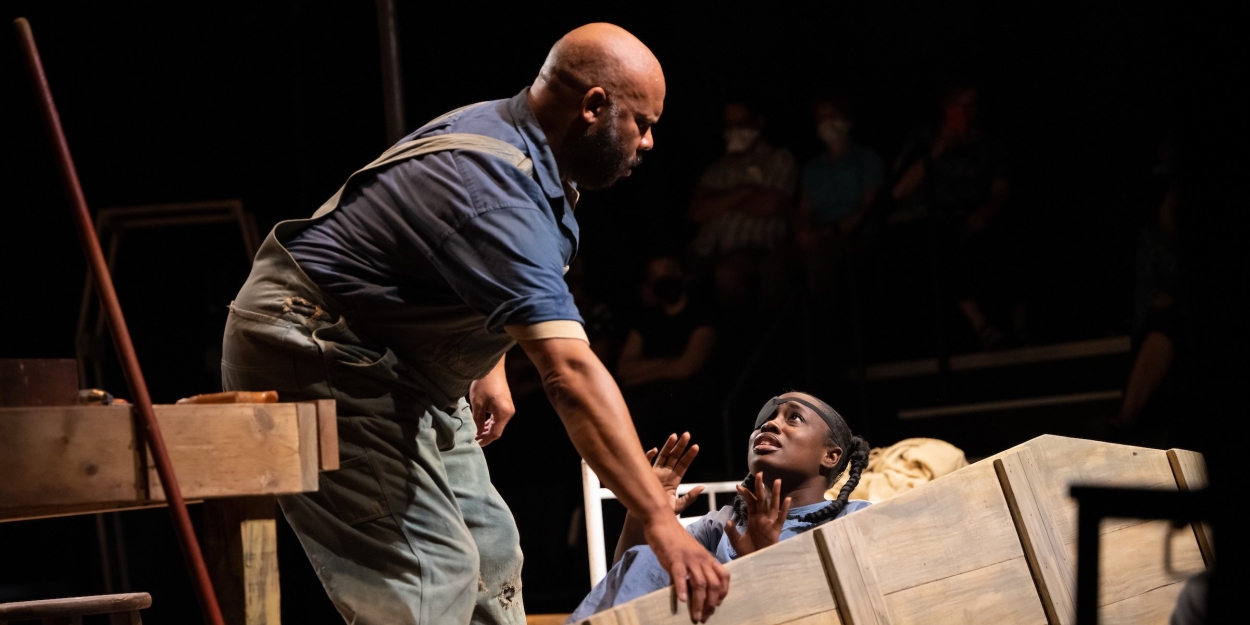Review: CATF's THE HOUSE OF THE NEGRO INSANE is a Riveting, Mind-Blowing Experience
Contemporary American Theater Festival in Shepherdstown, West Virginia Is Back in Stride!

Some plays set in the past enable you to escape the troubles of the day for awhile. Neat and clever, they give you that respite you think you need, in order to cope.
Then there are plays that immerse you in a past that is still all too present. Rough to watch, in theory; but as you leave the theatre, you realize that you have gained a greater insight into the struggles that go on around you every day. And with that insight can come a more open heart, and a renewed determination to find a way out of the troubles that face us.
Terence Anthony's offering at this year's Contemporary American Theater Festival, "The House of the Negro Insane," (directed vy Cheryl Lynn Bruce) will sweep you up in a tornado of emotions and deliver a few gut-punches as well, with riveting characters whose challenges make our own problems look as trivial as that fly landing on your picnic blanket. A polished piece of playwriting, this piece-now finally launched, after the long COVID hiatus-should find its place on stages across the country.
The play's genesis was Anthony's discovery that one of the daughters of Henrietta Lacks-a black woman whose body was used without her permission for scientific research-was herself incarcerated at a 'Hospital for the Negro Insane' in the 1950's. As an inmate, it's likely that her own body, like her mother's, was used for a variety of dubious experiments and treatments.
Set in an institution in 1930's Oklahoma, in a cabin where the hospital's coffins are produced, the play begins with news that the white foreman, Henry (played with an astonishing amount of grit and vinegar by Christopher Halladay), has been forced to become a day-laborer at a nearby farm. Henry's status as (effectively) an indentured servant, leaves the cabin empty for Attius, a black carpenter who-truth be known-does the bulk of the work.
What's fascinating about "House of the Negro Insane" is Anthony's added emphasis on the status of lower-class whites, who in some instances were just as powerless as the blacks they'd been raised to feel superior to. The relationship between Henry and Attius is complex, and Attius' solid work ethic becomes one major bone of contention between the two.
As Attius, Jefferson A. Russell delivers a quietly powerful performance, one of the highlights of this year's festival. From the precision with which he sweeps the floor, to the way he lays out his tools, you see a man whose daily routine, while circumscribed, brings some level of peace in a troubled world, to a man with a troubled past.
Attius' stoic work days are interrupted when, in Henry's absence, first one and then two young women escape from the hospital and seek refuge in the shop. As Effie, CG blazes her way through the cabin, self-assured and determined to live her own life (a determination which, very likely, was what got Effie declared mentally unfit). Her passionate desire for freedom and a better life soon finds a convert in young Madeleine (the luminous Lenique Vincent), who was recently left at the hospital by a family incapable of dealing with her bouts of epilepsy.
At this point a magic, dream-like sequence becomes another theme here; Attius, raised by a school-teacher, has vivid memories of a record of an orchestral piece his father used to play; at times he pauses to remember, and bask in the memory of it. Sound designer Sharath Patel creates a fascinating soundscape, taking a passage from Igor Stravinsky's "Firebird" ballet suite-at first, as played on a 78-rpm Victrola, but then as Attius' imagination conjures it, in full concert-hall sound, while lighting designer John D. Alexander bathes Attius and the stage in a dreamy, reddish glow.
Because Attius knows only the music, young Madeleine sets about crafting a story about a Firebird-she's never heard a note of what Attius hears in his memories, and what's fascinating is the way in which this story, which takes on a life of its own, reflects their situation and their challenges.
Scenic designer Claire Deliso gives us a barest-of-bones carpenter's space, complete with unfinished wood floors, planks, vises, hammers, with tin cans for nails. As each of the black inmates are introduced, however, they take a stand in a coffin-shaped doorway, before entering the action. And although at one point, a stray coffin becomes a refuge for one of the characters, the limitations imposed on these characters are social and psychological, as well as physical. They are, for them, seemingly inescapable.
Here's hoping that, through plays like Anthony's "The House of the Negro Insane," we can find our way beyond our own limitations.
Production Photo: Jefferson A. Russell and Lenique Vincent in the world premiere of The House of the Negro Insane by Terence Anthony . Photo by Seth Freeman.
Running Time: 90 minutes without Intermission.
The House of the Negro Insane runs as a part of the Contemporary American Theatre Festival, through July 31 in Studio 112 at Shepherd University in Shepherdstown, West Virginia.
For tickets visit https://catf.org/buy-tickets/ . You can also email the box office at boxoffice@catf.org or call them at 681-240-2283.
Reader Reviews
Videos

